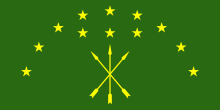Adyghe people
The ethnonym Adyghe (Adyghe: Адыгэ, romanized: Adygè; Russian: Адыги, romanized: Adygi) is used as an endonym by the Caucasian-speaking Circassians of the North Caucasus and as a demonym for the inhabitants of the Republic of Adygea, a federal subject of Russia located in the southwestern part of European Russia, enclaved within Krasnodar Krai, where it is also rendered as Adygeans (Russian: Адыгейцы, romanized: Adygeytsy).[a] The Adygeans (of Adygea) speak the Adyghe language.
| Total population | |
|---|---|
| 250,000 (est) | |
| Regions with significant populations | |
| 124,835 107,048 13,834 584[1] | |
| 600[2] | |
| 4,000[3][4]–5,000[5] | |
| Languages | |
| Adyghe (native), Russian | |
| Religion | |
| Predominantly Sunni Islam with Khabzeist, irreligious and Christian minorities | |
| Related ethnic groups | |
| Other Circassians and Abazgi (Abkhaz, Abazin) | |
Ethnology
The Adyghe people are one of the Circassian peoples, along with the Cherkess (of Karachay-Cherkessia) and Kabards (of Kabardino-Balkaria), from whom they are geographically separated by the Slav-inhabited Laba region.[6] The languages of the Adygheans, Cherkess and Kabards are mutually intelligible, however, there is a consensus that these are typologically distinct languages.[7] The standard (literary) Adyghe language is based on the dialect of the Temirgoy tribe.[8]
The Adygheans, known as "western Circassians" per Soviet terminology from the 1930s, use a written language separated by Soviet policy from those of the Cherkess ("central Circassians") and Kabards ("eastern Circassians"), despite the possibility to have a unified one. The Adyghe-Cherkess Autonomous Oblast was established in July 1922, "Cherkess" being dropped from the name in August 1936.[9]
The Circassian peoples are divided into tribes or clans (tlapq). There are ten Adyghe tribes (or subgroups),[10][11] out of which four are identified as speaking mutually intelligible Adyghe dialects: Abzakh, Bzhedug, Temirgoy and Shapsug.[10][8] The Shapsug were counted as a separate ethnic group in the censuses.[12]
Population
.png)
According to the 2010 census of Russia, the number of self-declared ethnic "Adyghe" is 124,835 (0.09%). The community included 107,048 in Adygea itself (ca. 25% of the republic's population), 13,834 in Krasnodar Krai, 569 in Moscow.[12] The majority of the population in Adygea declare as Russians (63.6%). In 2002 it was estimated that the community numbered 131,000 in all of Russia.[6] The other closely related groups, Kabards and Cherkess, numbered 516,826 (0.38%) and 73,184 (0.05%), respectively.[12] Those that declared as Shapsug, who speak an Adyghe dialect and are regarded an Adyghe subgroup, numbered 3,882.[12]
There is a significant Adyghe diaspora. It was estimated in 1997 that there were 71,000 Adyghe-speakers in Turkey, 44,000 in Jordan, and 25,000 in Syria.[13]
History
The political history of the Adyghe in Adygea since the Russian Revolution is complex. On 27 July 1922, a Circassian (Adygea) Autonomous Oblast was established in the Kuban-Black Sea Oblast, which would later become Krasnodar Krai. After several name changes, the Adyghe Autonomous Oblast was established on 3 August 1928. On 5 October 1990, the Adygea ASSR was proclaimed and separated from Krasnodar Krai. On 24 March 1992, it became the Republic of Adygea. A significant population of the Adyghe community now lives in the Black Sea region of Northern Turkey where their culture is preserved in villages in the area.[14]
Annotations
- ^ In Russian, Adygea's Circassian residents are called Adygejtsy (Адыгейцы, meaning 'those [of the Republic] of Adygea'), whereas the Circassians in general are called Adygi (Адыги, meaning 'the Adyghe'). In English terminology, on the other hand, many foreigners fail to distinguish between these Russian-specific administrative (former) and ethnolinguistic (latter) terms, and misuse the word Adyghe to refer only to the Adyghe in Republic of Adygea (only a small part of the historical Circassian lands). The majority of the Circassians in Russia today reside in neighbouring regions of Adygea.
References
- Официальный сайт Всероссийской переписи населения 2010 года. Информационные материалы об окончательных итогах Всероссийской переписи населения 2010 года (in Russian)
- "About number and composition population of Ukraine by data All-Ukrainian census of the population 2001". Ukraine Census 2001. State Statistics Committee of Ukraine. Archived from the original on 17 December 2011. Retrieved 17 January 2012.
- Besleney, Zeynel Abidin (2014). The Circassian Diaspora in Turkey: A Political History. Routledge. p. 96. ISBN 978-1317910046.
- Torstrick, Rebecca L. (2004). Culture and Customs of Israel. Greenwood Publishing Group. p. 46. ISBN 978-0313320910.
- Louër, Laurence (2007). To be an Arab in Israel. Columbia University Press. p. 20. ISBN 978-0231140683.
- Minahan 2002, p. 36.
- Hewitt, George (2005). "North West Caucasian" (PDF). Lingua. 115 (1–2): 17. doi:10.1016/j.lingua.2003.06.003.
- Michael Fortescue; Marianne Mithun; Nicholas Evans (29 July 2017). The Oxford Handbook of Polysynthesis. Oxford University Press. pp. 949–. ISBN 978-0-19-968320-8.
- Olson, Pappas & Pappas 1994, p. 152.
- Olson, Pappas & Pappas 1994, p. 15.
- Minahan 2002, p. 37.
- 2010 census of Russia
- Anatole Lyovin (1997). An Introduction to the Languages of the World. Oxford University Press. pp. 57–. ISBN 978-0-19-508116-9.
- "Adyghe in Turkey". Archived from the original on 2011-08-21. Retrieved 2014-09-16.
Sources
- James Minahan (2002). "Adyge". Encyclopedia of the Stateless Nations: A-C. Greenwood Publishing Group. ISBN 978-0-313-32109-2.
- Alexandre Bennigsen; S. Enders Wimbush (1986). Muslims of the Soviet empire: a guide. Indiana University Press. ISBN 978-0-253-33958-4.
- James Stuart Olson; Lee Brigance Pappas; Nicholas Charles Pappas (1994). An Ethnohistorical Dictionary of the Russian and Soviet Empires. Greenwood Publishing Group. pp. 152–. ISBN 978-0-313-27497-8.

